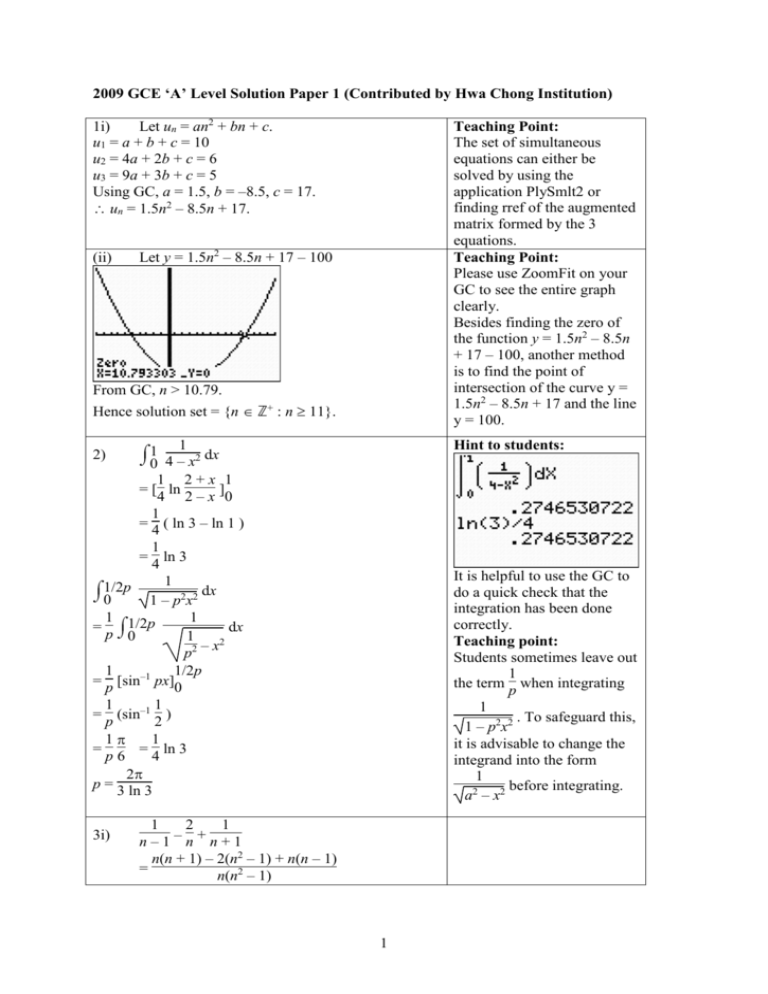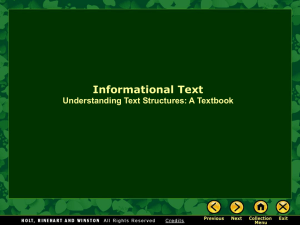2009 A Level H2 Maths Solution
advertisement

2009 GCE ‘A’ Level Solution Paper 1 (Contributed by Hwa Chong Institution)
1i)
Let un = an2 + bn + c.
u1 = a + b + c = 10
u2 = 4a + 2b + c = 6
u3 = 9a + 3b + c = 5
Using GC, a = 1.5, b = –8.5, c = 17.
un = 1.5n2 – 8.5n + 17.
(ii)
Teaching Point:
The set of simultaneous
equations can either be
solved by using the
application PlySmlt2 or
finding rref of the augmented
matrix formed by the 3
equations.
Teaching Point:
Please use ZoomFit on your
GC to see the entire graph
clearly.
Besides finding the zero of
the function y = 1.5n2 – 8.5n
+ 17 – 100, another method
is to find the point of
intersection of the curve y =
1.5n2 – 8.5n + 17 and the line
y = 100.
Let y = 1.5n2 – 8.5n + 17 – 100
From GC, n > 10.79.
Hence solution set = {n ℤ+ : n 11}.
1
1
0 4 – x2 dx
1 2+x 1
= [4 ln 2 – x ]0
1
= 4 ( ln 3 – ln 1 )
1
= 4 ln 3
1
1/2p
dx
0
1 – p2x2
1 1/2p
1
=p
dx
0
1
2
p2 – x
1
1/2p
= p [sin–1 px]0
1
1
= p (sin–1 2 )
1
1
= p 6 = 4 ln 3
2
p = 3 ln 3
Hint to students:
2)
3i)
It is helpful to use the GC to
do a quick check that the
integration has been done
correctly.
Teaching point:
Students sometimes leave out
1
the term p when integrating
1
. To safeguard this,
1 – p2x2
it is advisable to change the
integrand into the form
1
before integrating.
2
a – x2
1
2
1
–
+
n–1 n n+1
n(n + 1) – 2(n2 – 1) + n(n – 1)
=
n(n2 – 1)
1
2
= n3 – n
Shown
A = 2.
n
(ii)
1
r3 – r
r=2
1 n 2
= 2 r3 – r
r=2
1 n
1
2
1
=2 (r–1–r+r+1)
r=2
1
1 2 1
=2
[1–2+3
1 2 1
+2–3+4
1 2 1
+3–4+5
:
:
:
:
1
2
1
+n–2–n–1+n
1
2
1
+n–1–n+n+1]
1 1 1
1
=2[2–n+n+1]
(iii)
1
1
As n , n 0 and n + 1 0.
the series converges to the value
4i)
1
.
4
f(27) + f(45)
= f(23) + f(41)
= f(19) + f(37)
:
:
= f(3) + f(1)
=5+6
= 11
2
(ii)
Teaching Point:
Students should be advised to
sketch a clear and properly–
labelled graph.
y
7
3
–7 –6 –4 –2
(iii)
2
4
6
8
10
3 f(x) dx
–4
2
2
4
3
= 2
0 7 – x dx + 2 2x – 1 dx + 2 2x – 1 dx
x3 2
4
3
= 2[7x – 3 ]0 + [x2 – x]2 + [x2 – x]2
8
= 2[14 – 3 ] + [12 – 2] + [6 – 2]
2
= 363
5)
n
x
Hint to students:
The area under the curve
from x = –4 to x = –2 is
exactly the same as the area
from x = 0 to x = 2. Hence
2
the factor 2 in front of
0 7
– x2 dx.
The area from x = –2 to x = 0
is the same as the area from x
= 2 to x = 4. It would be
0
wrong to find
–2 2x – 1 dx.
Let Pn be the statement:
1
r2 = 6 n(n + 1)(2n + 1).
r=1
When n = 1:
LHS = 12 = 1
1
RHS = 6 1(2)(3) = 1 = LHS
P1 is true.
Assume that Pk is true for some k ℤ +
k
1
i.e. r2 = 6 k(k + 1)(2k + 1).
r=1
Teaching Point:
Some students make the
mistake of writing “Assume
that Pk is true for all k ℤ +”.
It should be either “some k”
or “a k”. Clearly, if you
assume that it is true for all k,
then there is nothing to
prove.
Prove that Pk+1 is also true
k+1
1
i.e. r2 = 6 (k + 1)(k + 2)(2k + 3).
r=1
LHS
k
= r2
r=1
+ (k + 1)2
3
1
= 6 k(k + 1)(2k + 1) + (k + 1)2
Teaching Point:
Students are advised to take
1
out the common factor 6 (k +
1) instead of expanding
everything and then
factorising later. Clearly a
waste of effort.
1
= 6 (k + 1)[ k(2k + 1) + 6(k + 1) ]
1
= 6 (k + 1)(2k2 + 7k + 6)
1
= 6 (k + 1)(k + 2)(2k + 3)
= RHS
Since P1 is true and Pk true Pk+1 true, hence by Math
Induction, Pn is true for all n ℤ +.
6i)
3
–1
– 6
Hint to students:
Students must realise that x =
–2 is a vertical asymptote and
draw it even though it does
not appear on the Graphing
Calculator.
y=1
2
6
– 3
x = –2
(ii)
x–2
x2 y2
Substitute y = x + 2 into 6 + 3 = 1:
x2 1 x – 2 2
6 + 3 x + 2 = 1:
x2(x + 2)2 + 2(x – 2)2 = 6(x + 2)2
2(x – 2)2 = (x + 2)2 (6 – x2) Shown
(iii) Method 1:
Find the points of intersection from the original graphs.
From GC, x = –0.515 or 2.45
4
Hint to students:
The question requires
students to “show
algebraically”. It would be
wrong if students show that
the numerical values of the
points of intersection
obtained from the GC satisfy
the given equation.
Teaching Point:
Students have a choice of
using Method 1 (since the
graphs have already been
plotted on the GC) or Method
2 which is also relatively
straight forward..
Method 2:
Sketch y = 2(x – 2)2 – (x + 2)2 (6 – x2)
From GC, x = –0.515 or 2.45
7i)
f (x) = –sin x ecos x = – sin x f(x)
f (x) = – sin x f (x) – cos x f(x)
f(0) = e
f (0) = 0
f (0) = –e
e
f(x) = e + 0x – 2 x2 + ...
e
= e – 2 x2 + ...
Hint to students:
It is helpful to use the GC to
check the value of the
derivative at x = 0.
1
a + bx2
1 1
=a
bx2
1+ a
1
b
= a (1 + a x2)–1
1
b
= a (1 – a x2 + ...)
1 b
e
= a – a2 x2 + ... = e – 2 x2 + ...
1
1
a=ea=e
b
e
e
1
– a2 = – 2 be2 = 2 b = 2e
(ii)
8i)
Hint to students:
It is easier to use the
expansion (1 + x)–1 = 1 – x +
x2 –... instead of the general
Binomial Expansion formula
in this case.
ar24 = 20r24 = 5
1
r24 = 4
5
12 1
2
Total length of all bars
< S
20
=
12 1
1–
2
= 356.343
< 357
r=
(ii)
L = 20
12 25
1
1–
2
Hint to students:
Since all the lengths are
positive, students need to
realise that the total length of
all the bars is less than the
sum to infinity.
Shown
= 272.2573
12 1
1–
2
12 12
1
Length of 13th bar = 20
2
1
= 20 2
= 10
Let b = length of first bar of instrument B.
25
2 [ 2b + 24d ] = L
L
b + 12d = 25
Also b + 24d = 5
L
So 12d = 5 – 25
272.2573
=5–
25
d = –0.49086
Length of longest bar
=b
= 5 – 24(–0.49086)
= 16.8 cm
9i)
z7
=1+i
= 2 ei/4
= 2 ei(2k+/4)
2k
i( 7 + 28)
1/14
z=2 e
, k = 0, 1, 2, 3
Hint to students:
Since the arguments must lie
in the principal range, k must
take the values 0, 1, 2, 3.
6
(ii)
Hint to students:
Students must realise that all
the roots have the same
modulus 21/14 and are all
2
spaced 7 radians apart on
the Argand Diagram.
2/7
2/7
2/7
2/7
2/7
/28
/4
2/7
Substituting z = 0 into | z – z1 | = | z – z2 |:
| 0 – z1 | = | z1 | = 21/14
| 0 – z2 | = | z2 | = 21/14
Since z = 0 satisfies the equation | z – z1 | = | z – z2 |, the
locus passes through the origin.
(iii)
z2
/7
/7
/28
z1
Equation of locus is y = x tan ( 28 + 7 )
5
= x tan 28
10i)
2 –1
1 2
3 1
cos =
4+1+9 1+4+1
3
=
14 6
= 70.9
Hint to students:
The question specified “acute
angle”. Hence the modulus
sign. In this case, it makes no
difference to the answer
though.
7
(ii)
Solving 2x + y + 3z = 1
–x + 2y + z = 2
Teaching Point:
Students can either use the
application PlySmlt2 or find
the rref of the augmented
matrix formed by the 2
equations.
0
–1
1
From GC, the equation of l is r = + –1 .
0
1
(iii) Substitute x = –, y = 1 – , z = into the
equation of p3 :
LHS
= –2 + 1 – + 3 – 1 + k( + 2(1 – ) + – 2)
=0
for any
Hence l lies in p3 for all k.
Substitute x = 2, y = 3, z = 4 into the equation of p3 :
LHS
= 4 + 3 + 12 – 1 + k(–2 + 6 + 4 – 2)
= 18 + 6k = 0
k = –3
equation of plane is 2x + y + 3z – 1 –3(–x + 2y + z –
2) = 0
i.e. 5x – 5y + 5 = 0
i.e. x – y + 1 = 0
11i)
(ii)
Teaching Point:
Students must show clearly
the asymptotic nature of the
graph as it approaches the xaxis.
dy
dx
= e–x + x e–x (–2x)
2
2
Hint to students:
Students can use the GC to
8
= e–x (1 – 2x2) = 0
1
x2 = 2
1
1
x=
,–
2
2
1 –1/2
1 –1/2
y=
e ,–
e
2
2
1 1
turning points = ( , e–1/2 )
2 2
1
1 –1/2
and (–
,–
e )
2
2
2
(iii)
check that these turning
points are numerically
correct.
du
u = x2 dx = 2x
When x = 0, u = 0
When x = n, u = n2
2
n x e–x dx
0
n2 1 –u
=
0 2 e du
1
n2
= [–e–u ]0
2
2
1
= 2 [1 – e–n ]
2
1
As n , e–n 0, so area = 2
(iv)
Hint to students:
Students can use the GC to
check that the area is
numerically correct.
2 | f(x) | dx
–2
2
=2
0 f(x) dx
= 1 – e–4
Hint to students:
The GC can be used to do a
quick check that the answer
is numerically correct.
1 2 –2x dx
Volume =
0 x e
= 0.363
2
(v)
9
2009 GCE ‘A’ Level Solution Paper 2
1i)
(ii)
Method 1:
dx
dt = 2t + 4
dy
2
dt = 3t + 2t
dy 3t2 + 2t
dx = 2t + 4
Hint to students:
The gradient of the curve at t = 2 can
either be obtained algebraically (Method
1) or from the GC (Method 2).
dy 16
When t = 2: x = 12, y = 12, dx = 8 = 2
Equation of l is
y – 12 = 2( x – 12)
i.e. y = 2x – 12
Method 2:
dy
When t = 2: x = 12, y = 12, dx = 2
Equation of l is
y – 12 = 2( x – 12)
i.e. y = 2x – 12
(iii) Substitute x = t2 + 4t, y = t3 + t2 into
equation of l :
t3 + t2 = 2(t2 + 4t) – 12
t3 – t2 – 8t + 12 = 0
10
(t – 2)(t2 + t – 6) = 0
(t – 2)(t – 2)(t + 3) = 0
t = 2 (reject since this gives us the point P), –3
x = 9 – 12 = –3
y = –27 + 9 = –18
coordinates of Q is (–3, –18).
2i)
By Ratio Theorem,
OA + 2OB
OP =
3
14
11
1
= 3 14 + 2–13
14
2
36
1
= 3 –12
18
12
= –4
6
coordinates of P is (12, –4, 6).
Hint to students:
Some students have the mistaken notion
2
that OP = 3 AB .
11
14
–3
1
–13
14
–27
(ii)
AB = – = = –39
2 14 –12
4
1
6
AB OP = –39 2–2
4 3
= –6(6 – 18 + 12)
=0
Hence AB & OP are perpendicular.
Hint to students:
This is a good place to check that the
answer obtained in part (i) is correct. If
students cannot show that AB and OP are
perpendicular, then they should suspect
that they have made mistakes in their
working in part (i).
(iii)
c=
A
P
B
They should realise that OP may not be
parallel to AB at all, and that the Ratio
Theorem is the quickest way to find OP .
6
1
–2
36 + 4 + 9 3
6
1
–2
=7
3
| a c | is the length of the projection of the
vector a on OP.
(iv)
14 12
a p = 14 –4
14 6
1
6
= 14 1 2–2
1
3
3+2
= 28 –(3 – 6)
–2 – 6
Hint to students:
It is advisable to remove common factors
before finding cross product to simplify
the multiplication and reduce chances of
computational mistakes.
11
5
= 28 3
–8
| a p | is the area of the parallelogram formed
by the vectors a and p.
1
Area of triangle OAP = 2 | a p |
5
1
= 2 28 3
–8
= 14 25 + 9 + 64
= 14 98
= 98 2
3i)
ax
Let y = bx – a
Hint to students:
Students should be able to spot that f(x) =
f –1(x) immediately. This enables them to
work out f 2(x) effortlessly without any
computation at all.
bxy – ay = ax
bxy – ax = ay
x(by – a) = ay
ay
x = by – a
ax
f –1(x) =
bx – a
f(x) = f –1(x)
f 2(x) = x
Hint to students:
f 2(x) is the identity function. Hence range
of f 2 = domain of f.
a
Range of f 2 = ℝ\{ b }
(ii)
a
Rg = ℝ\{ 0 } ⊈ Df = ℝ\{ b } since a 0.
instead of just quoting “Rg ⊈ Df ”.
Hence fg does not exist.
f –1(x) = x
ax
bx – a = x
ax = bx2 – ax
2
bx – 2ax = 0
x(bx – 2a) = 0
2a
x = 0 or b
(iii)
4)
d2n
dt2 = 10 – 6t
dn
2
dt = 10t – 3t + c,
n = 5t2 – t3 + ct + d,
Teaching Point:
Students are reminded to give Rg and Df
where c = constant
where d = constant
12
When t = 0, n = 100
100 = d
n = 5t2 – t3 + ct + 100
Hint to students:
If students choose to plot using c = –1, 0,
1, the three curves tend to be very close
together. Students can try using c = –10,
0, 10 instead.
c = 10
c=0
100
c = –10
(ii)
dn
dt = 3 – 0.02n
Hint to students:
Students must include modulus sign when
1
integrating 3 – 0.02n since 3 – 0.02n may
be negative. However they are reminded
to introduce A = e–0.02c before
substituting t = 0, n = 100.
1
3 – 0.02n dn = dt
ln | 3 – 0.02n |
=t+c
–0.02
ln | 3 – 0.02n | = –0.02t – 0.02c
| 3 – 0.02n | = e–0.02t e–0.02c
3 – 0.02n = e–0.02t e–0.02c
= Ae–0.02t
where A = e–0.02c
When t = 0, n = 100:
3–2=A
3 – 0.02n = e–0.02t
0.02n = 3 – e–0.02t
n = 150 – 50e–0.02t
As t , n 150
the population will stabilise at 150 000.
5)
The manager can choose to survey, say,
50 male cinema–goers and 50 female cinema–
goers. He is free to choose anyone convenient to
meet his quota.
Hint to students:
There are many ways to answer these two
parts of the question. All reasonable
answers will be accepted.
One disadvantage of quota sampling is that the
sample obtained is likely to be biased.
6i)
Hint to students:
Students are reminded to label and
indicate the scale on the axes. It is
advisable to draw the scatter diagram to
scale and to copy what appears on the
screen of the GC as closely as possible.
t
40
20
x
1930
2000
13
(ii)
A linear model may not be appropriate
since there is a certain limit to how fast a person
can complete the distance. This is also evident in
the scatter diagram, which shows a slight
reduction in the rate of decrease of the record
time.
(iii)
A quadratic model would show the record time
increasing again in the future, which is
impossible. Hence a quadratic model would not
be appropriate.
(iv)
By GC, the regression line is ln t = 34.853 –
0.016128x.
The predicted world record time as at 1st January
2010 is 3 min 30 + e34.853 – 0.016128(2010)
= 3 min 30 s + 11.424 s
= 3 min 41.4 s.
14
Since x = 2010 is outside the range of the data
values, the prediction is not reliable.
7i)
P(faulty)
= 0.25 0.05 + 0.75 0.03
= 0.035
(ii)
f(p)
= P(supplied by A | faulty)
P(supplied by A faulty)
=
P(faulty)
p
100 0.05
= p
100 – p
0.05
+
100
100 0.03
0.05p
= 0.05p + 3 – 0.03p
0.05p
= 0.02p + 3
Shown
(0.02p + 3)0.05 – 0.05p(0.02)
f (p) =
(0.02p + 3)2
0.15
=
> 0 for all 0 p 100.
(0.02p + 3)2
Hence f is an increasing function for 0 p 100.
This means that as we buy more and more
components from A, it is more likely that a
randomly chosen component that is faulty was
supplied by A.
Hint to students:
The question requires the candidate to
“prove by differentiation”. It would be
wrong to sketch a graph to show that it is
increasing.
Since there are 8 letters, including 3 E’s,
8!
no. of ways = 3! = 6720
8i)
(ii)
Method 1:
No. of ways where T & D are together
7!
= 3! 2! = 1680
Hence no. of ways where T & D are not next to
one another = 6720 – 1680 = 5040
Method 2:
E
L
E
V
A
E
6!
The 6 letters besides T & D can be in 3! ways.
The letters T & D can be arranged in the 7 spaces
available in 7P2 ways.
15
Hint to students:
Using the Complementary Method
(Method 1) depends on the assumption
that the answer to part (i) is correct,
which should be the case. If there are any
doubts, students can use Method 2.
6!
Hence total no. of ways = 3! 7P2 = 5040.
(iii) The consonants and vowels must be
arranged like this:
CVCVCVCV
or
VCVCVCVC
The 4 consonants can be arranged in 4! ways.
4!
The 4 vowels can be arranged in 3! ways.
4!
Hence total no. of ways = 4! 2 = 192.
3!
(iv)
The letters can be arranged as follows:
or
or
or
_E__E__E
E___E__E
E__E___E
E__E__E_
Hint to students:
First make sure there are two letters
between any two E’s. This takes up 4
letters.
The remaining letter can be placed before
the first E, between the first 2 E’s,
between the last 2 E’s, or after the last E.
Total no. of ways = 5! 4 = 480.
9i)
Method 1:
0.12
M ~ N(2.5, n )
Teaching Point:
Students have a choice of either solving
algebraically (Method 1) or listing out the
probabilities and searching for the answer
(Method 2). It is individual preference.
P( M > 2.53) = 0.0668
P( M < 2.53) = 0.9332
2.53 – 2.5
P( Z <
) = 0.9332
0.1
n
0.3 n = 1.500056
n = 25
Method 2:
16
(ii)
Let M, S = thickness of a mechanics and
statistics textbook respectively.
M1 +... + M21 + S1 +...+ S24
~ N(212.5 + 242, 210.12 + 240.082)
= N(100.5, 0.3636)
Hint to students:
There is no need to square 21 and 24
when computing variance since we are
dealing with sums of normal variables.
P(M1 +... + M21 + S1 +...+ S24 100)
= 0.203
(iii) S1 +...+ S4 – 3M
~ N(42 – 32.5, 40.082 + 320.12)
= N(0.5, 0.1156)
Hint to students:
Students need to square 3 when
computing variance since we are dealing
with the multiple of a normal variable.
P(S1 +...+ S4 < 3M)
= P(S1 +...+ S4 – 3M < 0)
= 0.0707
(iv)
We assume that the thicknesses of
mechanics and statistics textbooks are
independent.
10i)
Unbiased estimate of the mean
86.4
= x = 9 = 9.6
Unbiased estimate of the variance
1
86.42
= s2 = 8 (835.92 – 9 ) = 0.81
Teaching Point:
The formula for the unbiased estimate of
the variance is found in MF15. There is
no need for students to memorise it.
(ii)
We assume that the distribution of the
mass of sugar in a packet is normal.
H0 : = 10
H1 : 10
X – 10
Under H0 , T =
0.81
9
~ t(8)
17
Since p–value = 0.219 > 0.05, we do not reject
H0 . There is insufficient evidence at the 5%
level to say that the mean mass of sugar in a
packet is not 10 grams.
The Central Limit Theorem does not apply in
this case since the sample size 9 is small.
(iii)
We would carry out a Z–test instead.
11i) Two assumptions are:
the colours of the n cars are independent of
one another.
the probability of a car being red is constant.
(ii)
R ~ B(20, 0.15)
P(4 R < 8)
= P(R 7) – P(R 3)
= 0.346
Hint to students:
Students have to be careful here since
P(R < 8) = P(R 7) and they have to
subtract P(R 3) instead of P(R 4).
(iii) Since n = 240 is large, np = 72 > 5, nq =
168 > 5, R ~ N(72, 50.4) approximately.
P(R < 60)
= P(R < 59.5)
(continuity correction)
0.0391
Hint to students:
Some students mix up the use of nq and
npq.
Also it is common for students to forget
to do continuity correction.
(iv)
Since n = 240 > 50, np = 4.8 < 5, R ~
Po(4.8) approximately.
The Poisson approximation is appropriate in this
case since mean = 4.8 4.704 = variance.
P(R = 3) 0.1517
to 4 decimal places.
(v)
P(R = 0 or 1)
= P(R = 0) + P(R = 1)
= (1 – p)20 + 20p(1 – p)19 = 0.2
18
(1 – p)20 + 20p(1 – p)19 – 0.2 = 0
Method 1:
From GC, p = 0.142.
Method 2:
From GC, p = 0.142.
Method 3:
19
From GC, p = 0.142.
20






